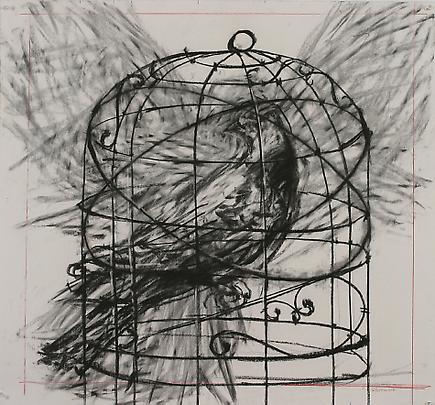Ariel
The cage was far too small for such a large bird. Any cage is too small for a bird; but this dusty iron one was hardly bigger than the bird herself. Her own waste festered on the floor of the cage, which no one ever cleaned, and the fumes rose up around her all day.
Once she had had a nub of bone to chew on, but she’d chewed that to dust long ago. Now she gnawed on the bars of the cage—not with any hope of escape, but only to push away her fear and loneliness.
The bird had been in the cage almost, but not quite, her whole life. Faint memories of some of other place and other kind of time haunted her. She worried over it. Was there really such a time? Could she open her wings full and free once?
Was there really a place called Sky: infinitely blue, infinitely accepting?
When memories of Sky came like hot arrows into her fearful heart, she would pull out her own feathers, one at a time, to forget. It hurt terribly, but the pain eased or hid the pain of missing Sky, at least for a while.
Sometimes she was certain she only imagined Sky—that Sky only stood for a place and time that was not this place, and not this time. But whatever Sky was, she longed for it.
The bird lived in an old, high-ceilinged apartment, well above the city streets, with a thin man in a red coat and a little girl in a purple, frothy dress. Once a week, the thin man would seize the cage and carry it outside, banging the bird inside to and fro, through noisy, smoke-blackened streets, and into a dark building. Once inside, the man’s wiry hands would reach inside the black bars, seize the bird, and stuff it inside a suffocating black sack. Then he stuffed the sack inside a black hat and left.
For hours, as the bird struggled for breath, she would listen to muffled noises: first shouts and curses and laughter; then the blare of off-key trumpets; then the sleek and booming voice of the man in the red coat.
Then, without warning, the sack was opened, and the bottom of the hat was smacked, forcing the stunned bird into the air. It would flutter desperately, awkwardly, stretching wings that had not been used in a week. Bright lights blinded it, the rising roar of a crowd made it flutter, terrified, unsure where to fly. Within seconds, the man’s hard hands were back around the bird, thrusting it back inside the sack. And soon enough, it was back in its cage on its table again.
It was the job of the girl in the frothy purple dress to give the bird food or water, but often she forgot, and when she remembered, her hands were not always satisfied only to leave the food, but had also to touch the bird, and her hands were hot and rough and cruel.
Once, after slipping the food in, the girl seized one of the bird’s wings and yanked, nearly breaking it. In pain and fear, the bird struck at the girl’s hand, hard. Then there was no food or water for many days, not until the bird was crumpled at the bottom of her cage, breathing shallow and fast, and the thin man shouted and hit the girl.
But mostly the girl and the thin man ignored the bird. And mostly the bird turned its back on the room to stare at the wall beside its cage, watching the changing light. The light was all it could see of the outdoors.
One day, the light shifted—or perhaps the thin man or the rough, forgetful girl had accidentally shifted the cage. In any case, on the wall behind the caged bird, another bird appeared: a dark, shadow bird, in a shadow cage.
Shadow bird, said the caged bird: look, your cage is only shadow. You could leave at any time. Open your wings, shadow bird, and fly.
But the shadow bird did not move.
Shadow bird, said the caged bird: My cage is iron bars, but yours is made of nothing at all. It is only the dream of a cage. The window is open, I smell the street and the dirt and the trees outside. Fly away.
But the shadow bird did not move.
Do you stay for me? asked the cage bird. I think you do. I think you came to keep me company, and you stay so that I am not alone in this place, so far from Sky. If birds could cry, the caged bird would have cried with gratitude. Not to be alone was more than she had hoped.
To show her gratitude, the caged bird raised her wings the few centimeters she could raise them. In response, the shadow bird raised its wings much higher, much fuller. The shadow bird’s wings were bigger even than the shadow cage itself.
So things seemed almost a little better for the bird, for a little while. And then without warning, they were much, much worse. Because one day, for fun, little girl put glue on the caged bird’s perch. The bird pulled and strained in agony, trying to free herself.
Just then the thin man, running late and impatient to leave, strode in, opened the cage, seized the bird, and pulled hard. The bird shrieked in pain, and as the cage swung through the city, the blood from her talons trailed across the street.
And when the hat was smacked, and the bird was flung out before bright lights and roaring crowds, she could fly no more than a few inches before she fell to the ground.
The crowd laughed.
When they got home, the thin man tossed the bird and its cage furiously onto the table. The bird’s ruined feet could not bear the perch, so she lay on her side on the the cage’s filthy floor, facing the wall and the shadow bird. The shadow bird lay down, too, in its shadow cage. They held each other’s eyes.
In the room, the thin man and the rough girl screamed at each other.
“I didn’t do anything!”
“Except cost me money and reputation with your stupid tricks! The bird’s useless now!”
“It isn’t my fault, it’s the stupid bird’s fault!”
And then maybe—because by now the caged bird was feverish, and its head felt too full and light—maybe the cage door was yanked open, and a small hand pulled her out, shouting. “Fly! Fly, stupid! I didn’t hurt you so bad, you’re just lazy!”
Maybe the small hand flung the sick, wounded bird into the air.
And then—at least it seemed to the caged bird that this happened—then, somehow, the bird found strength in her battered, half-feathered wings. She pulled at the air, and the air carried her up. She flew near the top of the ceiling, and then she turned and faced the man and the girl.
“See—“ the child began, in triumph. But then—or so it seemed to the feverish bird—the child’s eyes widened in fear. The bird-no-longer-caged could see herself, she thought, reflected in the child’s black pupils. She could see herself, and she could see her own bloody talons outstretched, and her sharp beak open.
She could see herself, as she stabbed and stabbed at the child’s soft face and throat, until those pupils could not see through the blood.
And when the thin man came at her, snatching at the air around her, waving his wiry arms—then it seemed to the bird that she served him just the same, over and over, and over and over, until his face and hands and hair were as bloody-red as his coat.
The man and girl lay still and quiet on the floor, then—oh quiet, quiet, quiet.
That is what the caged bird thought, at least. But if you were the policeman who entered the room, after neighbors reported terrible screams, and then terrible silence, you would have seen a bird in a locked cage, lying on its side, facing the wall, still and cold and dead.
On the floor, you would have seen a child in a blood-spattered, frothy purple frock, and a thin man in a red coat, their faces and throats pecked into bloody mess.
And you would see, if you were a noticing policeman, a shadow of the dead bird’s black cage against the wall.
But you wouldn’t see the shadow bird. Because the shadow bird was gone. The shadow bird had flown. The shadow bird had done what it had come to do, and had returned to the Sky.


As I’ve been in Houston these last several months, I’ve watched the unfolding story of the 5 year old starving boy locked in a closet beneath the stairs of his father and step mother’s home in Spring, TX. It’s such a ghastly story, it’s hard to fathom how it could happen. Kathy’s story “Ariel” captured the feelings of horror and disgust I’ve felt towards those people who should have been caring for the boy, but tortured him instead. Obviously, I substituted the defenseless boy for the defenseless bird in my comparison. The ugly awfulness of neglect and abuse is so hard for me to comprehend, but Kathy’s story gave me a hook upon which to hang my anger. As to the ending, yes, I do want to see their eyes gouged out. Alas, I’ll have to wait for the legal system to decide their fate. As for the boy, luckily he was spared death, although he came precariously close to the edge. I hope he can soar like the shadow bird now that he’s free!
Oh Kayna, what a terrible story! That breaks my heart.
The bird was a jerk, but I’m sad it’s dead. The people deserved it, though.
ha! I kind of love that you feel the bird is a jerk!
Not as much as frothy-dress-girl. It’s violent, but I kinda wish the bird had found a way to rip HER feet off.
Eh, This story already was violent. Go birdy! 😀
birdie*
birdy/birdie = works either way!